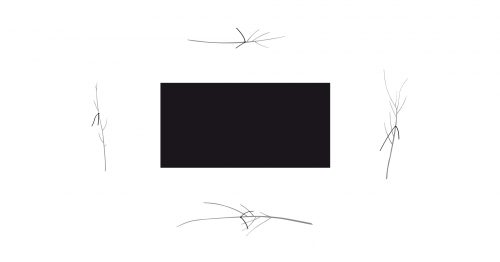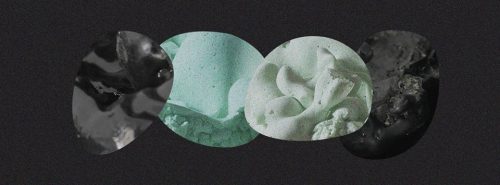 Dia Bögi
Dia Bögi
Saturn’s Trees
To understand human fate – regardless of time or culture – we often turn to the world of flora: almost involuntarily we borrow terms from the world and life cycle of trees to express periods in human life, such as the expressions offspring, budding, blossomed, withered, etc. In areas in which German is spoken, beginning in the 16th century, bare, dead trees were referred to as the trees of Saturn, an idiom tied to the association of Saturn with an introversive, contemplative personality.[1] “(The melancholic [Saturnine]) does not regard the unknown as something which must sooner or later be tracked down with appropriate training, but rather as the innermost centre of human existence and thinking.”[2] Similarly, the works of Dia Bögi are neither answers nor explanations. Rather, in the words of the artist, they are “attempts to accept irresolvable uncertainty”.
The central element of the exhibition is an area of the ground covered with coal dust, which recalls the gesture of cutting holes in frozen fishing ponds. Carbon, the fundamental element of all organic compounds, ensures the substances necessary for trees to be solid. Cutting holes in the ice, in contrast, is an act of intervention by man which disrupts the seemingly solid but in fact fragile layer. Four branches inserted into the ground draw attention to the border of the coal-covered area and the hidden dangers in the surface, which is thought to be solid enough to walk on. These branches, which appear to be on the brink of budding, were cut by Bögi from trees in the forest surrounding a lake. They are sprigs which, in contrast with the other branches in the wild, for some reason were thwarted in their springtime revival. They never grew leaves, and in their current state, stuck in “ice,” they have no chance of rebirth. However, passing and rebirth are not mutually exclusive, as the decay of a Christmas tree in Beuys’ studio for four years drew attention to another life cycle, the continuation of life in death.
The works presented in Dia Bögi’s exhibition Saturn’s Trees examine the reconciliation of rebirth, temporality, and passing.
[1] László F. Földényi: Caspar David Friedrich, Helikon, 1986, p. 4.
[2] László F. Földényi: A melankólia dicsérete (In Praise of Melancholy), Jelenkor, 2017, p. 30.
Sorry, this entry is only available in Hungarian

Almost Ready – Erasmus 2018
Exhibitors: Beatrice Dandová, Fabianne Jones, Hannah Juhasz, Lucia Malpeli, Hristina Mazneska, Isabelle Pead, Alma Peltola, Daniel Prenleloup, Jerome Sklorz,
Opening speech: Filp Csaba DLA az MKE Festő Tanszék tanszékvezetője
Opening: 2018. April 29. 18 pm
On view: 2018. May 3
Almost Ready
We can see posts of our creator friends „work in progress” daily frequency and many times a day on facebook. We get information from making work of art and work of art while preparing so that raise my interest like a movie trailer and trying to mood in advance for an future exhibition and we can still see how the artist work, as he does his job. We are use to this and mostly this mechanism works, we really look forward to the anticipated event, we almost confirm it, so it was, I saw this at a previous stage in a document photo.
But what happens then if that is the almost finished work of art, that work in progress will be presented in its almost ready state. In the view of the viewer, the idea of how the finished work of art looks in the now probable form. At all: when the work of art is ready?
Sorry, this entry is only available in Hungarian
Uretánia farkasai

URETÁNIA FARKASAI
Megnyitó: Április 10. 19:00 óra
Kiállító művészek: Leitner Levente, Sallay Dániel
Kurátor: Tóth Bernadett
Uretánia alapkoncepciója a szobrász művészpáros Sallay Dániel és Leitner Levente kooperációjából született meg, régi barátságuk és közös munkájuk során. Minden nap olyan anyagokkal dolgoznak, melyek károsak és veszélyesek mind rájuk és a környezetre nézve is.
Hosszú évek során érlelődött meg bennük ennek a különös világnak az ötlete. Ami igazából valóság… lehetne.
URETÁNIA – mint egy párhuzamos dimenzió és egyben saját jövőnk sötét jóslata. A két művész munkásságában régóta jelen lévő jelenség és kérdés egyben. Régóta foglalkoztatja őket ez az egyedi tematika, saját munkájuk és mindennapjaik inspirálták Uretánia világának megteremtését. Az Uretánia Farkasai címet viselő kiállítás, először biztosít bepillantást ennek a toxikus világnak a mindennapjaiba.
A munkák a mérgező és szennyezett világ anyagaiból készülnek, öltenek testet. A művek nem az elrettentést szolgálják, hanem ezek által nyerhetünk betekintést ebbe a világba, megláthatjuk, ami a felszín alatt rejtőzik. Ami zsigerien mélyen lapul meg, a bio – horror és Árny Pop valósága. Lehet ez egy figyelmezetés, de lehet felkérés egy táncra.
Támogató:
Nemzeti Kulturális Alap
http://www.nka.hu/




